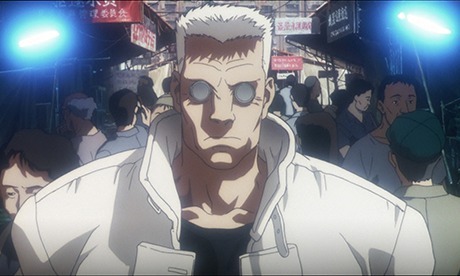

The film ends with the Major / Puppet Master looking out at the city, saying, “The net is vast and infinite.” Then we see the city from their vantage point, with the streets and canals resembling neural pathways. It isn’t human or inhuman, inorganic or organic. The city’s soul, much like the Major / Puppet Master hybrid at the end of the film, is harder to define. Its brain, on the other hand - the people who live within it and make it work - are still organic and alive. Similarly, the city’s body is also artificial, made of concrete, steel, and neon. She can’t see her soul, so she can’t prove it’s real. The contrast between the broken-down city and its human inhabitants may mirror one Ghost in the Shell subplot: the protagonist, the Major, questions whether she’s human, given that all her body is artificial except her brain, and by extension her soul. In Akira, there are so many protestors that they have to be processed in converted arenas. It’s very unlike, say, Akira, which shows how everyday life is constantly butting up against police, politics, and violent civil unrest. The visual cues suggest a rundown world, but the lives of everyday people are divorced from the actions of Section 9 and the politics going on in the film. The more I think about it, the harder it is to think of this place as necessarily dystopian. The signs still have muted colors and water damage. The building exteriors are still made of stained concrete.
#Ghost in the shell 1995 explained full
Even during the chase through the street market, everyone there is dressed in a similar manner.īut these places full of life aren’t depicted as that different from the ones in the garbage-collector sequence. Most of the people walking around are in business attire, or at least fashionable clothing. Shops line the streets, and construction scaffolding covers many of the buildings.įrom the street, we’re shown the interior of a restaurant, where all the patrons seem to be well dressed. Passenger-filled boats travel through the city’s many canals, as people meander down walkways that flank the channels. We don’t get our best look at the city until an extended montage a little later in the film. And though the signs for businesses block out much of the sky, all the shops are shuttered. Along their route, the buildings feel too close to the street. This is exemplified during a sequence that follows some garbage collectors. But even the signs appear faded by age and water damage. The only hint of green comes from the water stains on the ground, and the only other colors are found in the signs and billboards draping between buildings like overgrown ivy. Everything seems to be made of concrete - nothing natural grows in the city. The action scenes were as I remembered them, but what struck me more this time around was the world where Ghost in the Shell takes place.Īt first glance, you might call that world a cyberpunk dystopia.

Recently, though, I rewatched the film in a theater. What stuck out to me at the time were the action scenes - they’re slow to build but quick to unfold, with quick flashes of extreme violence that verge on body horror, as the organic and inorganic parts of people are torn apart. It was the most recent DVD release, which at the time looked amazing on my convex curved CRT TV. The last time I saw the original 1995 Ghost in the Shell was when I was in college, more than a decade ago. Have they gotten better like a fine wine, or are we drinking cork?
#Ghost in the shell 1995 explained tv
Does It Hold Up is a chance to reexperience f avorite childhood books, movies, TV shows, video games, and other cultural phenomenon decades later.


 0 kommentar(er)
0 kommentar(er)
